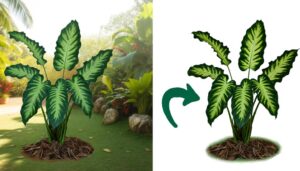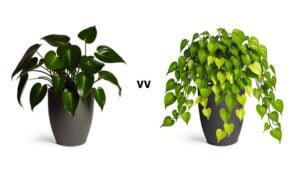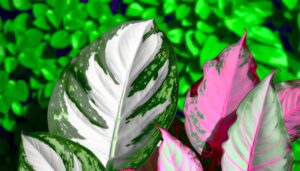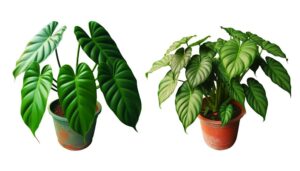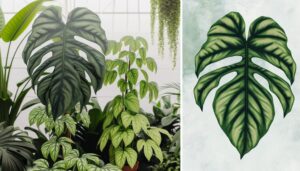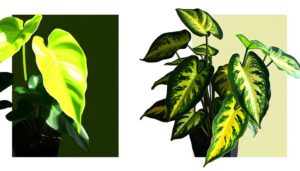Philodendron Lemon Lime Vs Moonlight: Which to Choose?
Philodendron Lemon Lime (Philodendron hederaceum) and Philodendron Moonlight, both from the Araceae family, exhibit unique differences in leaf coloration, growth habits, and light preferences. Lemon Lime features neon-yellow, smooth leaves and requires climbing support, thriving in 1000-2500 lumens.
Moonlight, with lime-green, leathery leaves, grows upright and prefers 2500-4000 lumens. Both plants prosper in humid, shaded tropical environments and need consistently moist, well-draining soil.
Distinct chlorophyll concentrations account for their foliage color differences, and careful management of light and water is essential for best growth. Discover more intricate care practices and propagation techniques for these vibrant plants ahead.
Comparison of Philodendron Lemon Lime and Philodendron Moonlight
| Feature | Philodendron Lemon Lime | Philodendron Moonlight |
|---|---|---|
| Scientific Name | Philodendron hederaceum ‘Lemon Lime’ | Philodendron ‘Moonlight’ |
| Common Name | Lemon Lime Philodendron | Moonlight Philodendron |
| Leaf Shape | Heart-shaped | Lance-shaped |
| Leaf Texture | Smooth | Smooth |
| Leaf Color | Bright lime green | Bright chartreuse to neon yellow |
| Growth Habit | Climbing vine | Upright, bushy |
| Mature Size | Up to 10-12 feet with support | Up to 2-3 feet tall and wide |
| Light Needs | Bright, indirect light | Bright, indirect light |
| Watering | Keep soil moist but not waterlogged | Keep soil moist but not waterlogged |
| Temperature | Prefers 65-80°F (18-27°C) | Prefers 65-80°F (18-27°C) |
| Humidity | Moderate to high (above 50%) | Moderate to high (above 50%) |
| Soil Type | Well-draining, rich potting mix | Well-draining, rich potting mix |
| Propagation | Stem cuttings | Stem cuttings |
| Toxicity | Toxic to pets and humans | Toxic to pets and humans |
| Special Care | Pruning to control size, regular fertilizing | Pruning to maintain shape, regular fertilizing |
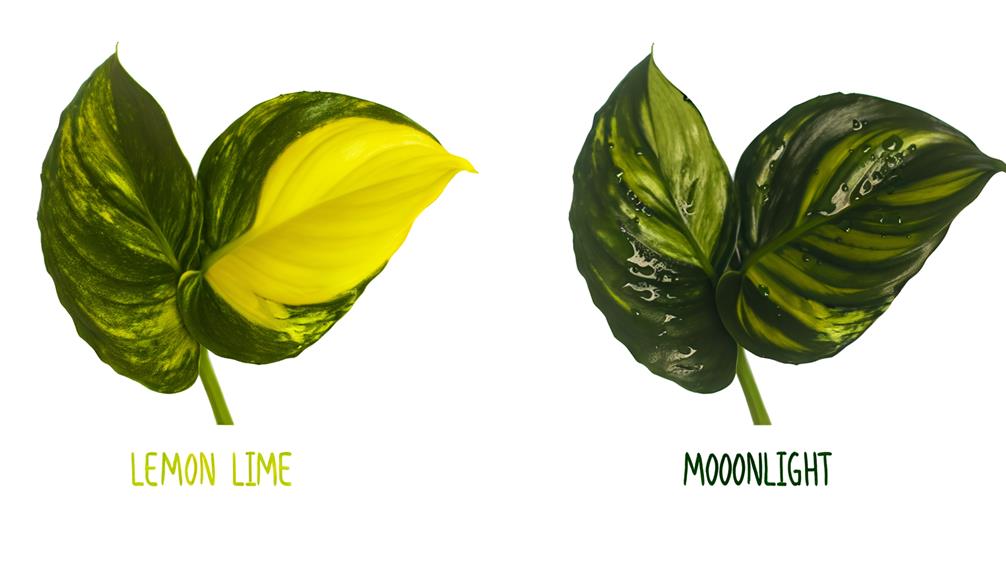
Origins and Background
Originating from the tropical regions of South America, Philodendron Lemon Lime and Moonlight are both part of the Araceae family, known for their diverse and vibrant foliage. These species thrive in humid, shaded environments, often under the canopy of larger trees.
Philodendron Lemon Lime, scientifically named Philodendron hederaceum, is a climbing variety that showcases its adaptability in various ecological niches. In contrast, Philodendron Moonlight, a hybrid of unknown parentage, exhibits a more compact growth form.
Both species are aroids, characterized by their inflorescence structure comprising a spadix and spathe. The genus Philodendron encompasses over 450 species, each exhibiting unique morphological adaptations that contribute to their ecological success in tropical understories, where competition for light and resources is intense.
Leaf Color and Texture
The Philodendron Lemon Lime exhibits bright, neon-yellow foliage with a smooth texture, whereas the Philodendron Moonlight features lime-green leaves with a slightly more leathery surface. These differences in leaf color and texture are essential for identification and impact their ornamental value.
The Lemon Lime’s vibrant leaves are smooth and soft to the touch, contributing to its striking visual appeal. In contrast, the Moonlight’s leaves possess a firmer, more robust texture, indicative of its slightly thicker leaf structure. Chlorophyll concentration differences account for the distinct color variations, with the Lemon Lime exhibiting higher levels of carotenoids.
These anatomical and physiological differences not only contribute to their unique aesthetic qualities but also influence their light absorption and photosynthetic efficiency.
Growth Habits
In examining the growth habits of Philodendron Lemon Lime and Moonlight, notable differences arise in their climbing versus upright tendencies, light requirements, and leaf size.
Philodendron Lemon Lime exhibits a vining growth habit, often necessitating support structures, whereas Moonlight maintains a more compact, self-supporting form.
Additionally, their photosynthetic efficiency and best light conditions vary, influencing both their growth rate and leaf morphology.
Climbing Vs. Upright Growth
Exhibiting distinct growth habits, Philodendron Lemon Lime tends to develop as a climbing plant, whereas Philodendron Moonlight typically exhibits an upright growth pattern.
Philodendron Lemon Lime utilizes aerial roots to anchor itself to surrounding structures, enabling vertical growth and extensive spreading. This vining characteristic necessitates support systems such as trellises or moss poles for best growth.
In contrast, Philodendron Moonlight demonstrates a self-supporting, rosette-like formation. Its erect stems and broader, more compact foliage create a bushier appearance, making it ideal for standalone display.
The divergent growth habits are fundamental to their care requirements and spatial planning within indoor environments, influencing factors such as pruning, support needs, and placement. Understanding these differences is essential for effective cultivation and aesthetic arrangement.
Leaf Size Differences
Beyond their specific light requirements, the Philodendron Lemon Lime and Philodendron Moonlight also exhibit distinct differences in leaf size and growth habits, contributing to their unique aesthetic and environmental adaptations.
Philodendron Lemon Lime typically produces elongated, heart-shaped leaves that can reach up to 12 inches in length, showcasing a vibrant chartreuse coloration. In contrast, Philodendron Moonlight features broader, more oval-shaped leaves that generally max out at around 8 inches, exhibiting a striking, neon-green hue.
The Lemon Lime’s vining growth habit contrasts with the Moonlight’s more compact and bushier form. These morphological differences influence not only their visual appeal but also their spatial requirements and overall impact within interior landscapes, making each suitable for different design needs and cultivation conditions.
Light Requirements
Understanding the light requirements for Philodendron Lemon Lime and Moonlight is essential for maximizing their growth and overall health. Both species thrive in bright, indirect light, but there are nuanced differences.
- Philodendron Lemon Lime: Prefers medium to bright, indirect light. Inadequate light can cause leggy growth, while excessive direct sunlight may scorch its leaves.
- Philodendron Moonlight: Tolerant of low light conditions but performs best in bright, indirect light. Overexposure to direct sunlight can cause leaf discoloration.
- General Guidelines: Avoid placing either plant in direct sunlight to prevent photoinhibition. Utilize sheer curtains or place them near north-facing windows to maintain optimal light conditions.
Adhering to these guidelines guarantees both Philodendrons exhibit robust foliage and vibrant coloration.
Watering Needs
Proper light exposure is complemented by adequate watering practices, which are essential for the health and vigor of Philodendron Lemon Lime and Moonlight. Both species thrive when kept in consistently moist, but not waterlogged, conditions.
Overwatering can lead to root rot, a detrimental condition caused by oxygen deprivation in the root zone. Conversely, underwatering results in desiccation stress, characterized by wilting and leaf browning. Employing a soil moisture meter can provide precise readings, ensuring ideal hydration.
Watering frequency should be adjusted based on seasonal variations; reduced watering is advisable during dormancy periods. Additionally, utilizing dechlorinated or distilled water minimizes the risk of chlorine toxicity, which can impede nutrient uptake.
Adhering to these guidelines promotes robust growth and vibrant foliage.
Soil Preferences
Understanding the soil preferences of Philodendron Lemon Lime and Moonlight is essential for best growth. Both varieties flourish in a well-draining, aerated substrate with a slightly acidic to neutral pH.
Ideal soil composition should include a blend of peat, perlite, and orchid bark to guarantee proper drainage and root aeration.
Ideal Soil Composition
Both Philodendron Lemon Lime and Moonlight thrive in a well-draining soil mix rich in organic matter, which guarantees aeration and retains adequate moisture without becoming waterlogged.
For best growth, the ideal soil composition should include:
- Peat Moss: Enhances moisture retention while maintaining a light, airy texture, preventing soil compaction.
- Perlite or Vermiculite: Improves drainage and aeration, essential for preventing root rot and promoting healthy root systems.
- Composted Organic Matter: Supplies essential nutrients and supports beneficial microbial activity, fostering robust plant development.
These components ensure a balanced medium that supports both nutrient uptake and proper water management. Incorporating these elements into the soil mix creates an environment conducive to the vigorous growth and vibrant foliage characteristic of Philodendron Lemon Lime and Moonlight.
Drainage and Aeration
Effective drainage and aeration are essential for preventing root rot and ensuring the best growth of Philodendron Lemon Lime and Moonlight. These plants thrive in well-draining soil that facilitates oxygen exchange, thereby preventing anaerobic conditions detrimental to root health. Incorporating perlite, orchid bark, and peat moss can greatly enhance soil structure.
Below is a comparison of soil components for best drainage and aeration:
| Component | Function | Benefit |
|---|---|---|
| Perlite | Improves aeration | Enhances root oxygenation |
| Orchid Bark | Increases drainage | Prevents waterlogging |
| Peat Moss | Retains moisture | Balances hydration and aeration |
| Coarse Sand | Enhances porosity | Promotes rapid drainage |
Selecting the appropriate soil mix is essential for maintaining the health and vigor of these philodendrons.
Ph Requirements
Maintaining an ideal pH level in the soil is critical for the nutrient uptake and overall health of Philodendron Lemon Lime and Moonlight. Both species thrive in slightly acidic to neutral soil, with a pH range of 5.5 to 7.0. This pH range optimizes the availability of essential nutrients such as nitrogen, phosphorus, and potassium, thereby promoting robust growth.
To guarantee proper pH levels, consider the following steps:
- Regular Testing: Utilize pH testing kits to monitor soil acidity.
- Soil Amendments: Adjust pH with lime to increase alkalinity or sulfur to enhance acidity.
- Organic Matter: Incorporate compost to stabilize pH and improve soil structure.
Adhering to these guidelines will promote a conducive growing environment for these philodendrons.
Fertilization
When fertilizing Philodendron Lemon Lime and Moonlight, it is vital to use a balanced, water-soluble fertilizer to ensure maximum nutrient absorption and plant health. Select a 20-20-20 NPK formulation, ensuring equal proportions of nitrogen, phosphorus, and potassium.
Apply the fertilizer biweekly during the growing season, typically from spring through early autumn. Dilute the solution to half the recommended strength to prevent nutrient burn.
Micronutrients such as magnesium, iron, and manganese are also necessary for best growth. It is recommended to conduct a soil test periodically to monitor nutrient levels and adjust fertilization practices accordingly.
Avoid fertilizing during the dormant winter months, as the reduced metabolic activity of the plants minimizes nutrient uptake.
Temperature and Humidity
When comparing Philodendron Lemon Lime and Moonlight, it is important to take into account their specific temperature and humidity needs. Both species thrive in an ideal temperature range of 65-80°F and prefer humidity levels between 60-80%.
Seasonal care tips include maintaining consistent environmental conditions and avoiding temperature fluctuations to promote growth.
Ideal Temperature Range
Both Philodendron Lemon Lime and Moonlight thrive in a temperature range of 65-80°F (18-27°C) with humidity levels between 60-80%. This ideal range ensures physiological processes such as photosynthesis and transpiration occur efficiently. Maintaining these conditions supports robust growth and vibrant foliage.
Specifically, there are three critical points to take into account:
- Temperature Stability: Sudden changes can stress the plants, leading to leaf discoloration or drop.
- Humidity Control: Proper humidity prevents issues like leaf tip browning and promotes overall plant health.
- Ventilation: Adequate air circulation mitigates the risk of fungal infections and pests.
Preferred Humidity Levels
Philodendron Lemon Lime and Moonlight both exhibit ideal growth when maintained in humidity levels ranging from 60% to 80%, as this range emulates their native tropical environments. Elevated humidity fosters best cellular function and photosynthetic efficiency, reducing transpiration stress.
In indoor settings, the use of humidifiers or pebble trays can help achieve the desired moisture levels. The importance of maintaining consistent humidity cannot be overstated, as fluctuations can lead to foliar damage and reduced vitality. Hygrometers are recommended for precise monitoring.
Additionally, misting the foliage periodically can enhance ambient humidity, though it should be done cautiously to prevent fungal issues. To sum up, proper humidity management is vital for sustaining the health and aesthetic appeal of these Philodendron varieties.
Seasonal Care Tips
Seasonal care for Philodendron Lemon Lime and Moonlight involves careful adjustments to temperature and humidity to mimic their natural habitat and promote growth throughout the year. These tropical plants thrive under specific conditions that must be replicated indoors.
- Winter: Maintain a temperature range of 65-75°F (18-24°C). Humidity should be kept above 50%, using a humidifier if necessary.
- Spring and Summer: Best growth occurs between 75-85°F (24-29°C). Increase humidity to 60-70% by misting or using pebble trays.
- Autumn: Gradually reduce temperatures back to 65-75°F (18-24°C) and maintain humidity levels around 50-60%.
Adhering to these seasonal guidelines ensures a favorable environment for strong and healthy philodendron growth.
Pruning and Maintenance
Proper trimming and upkeep are crucial for promoting healthy growth and foliage density in both the Philodendron Lemon Lime and Moonlight varieties. Regular trimming encourages the development of new shoots and helps in maintaining a compact, aesthetically pleasing form.
Utilize sterilized trimming shears to remove any yellowing or dead leaves, which can harbor pathogens. Additionally, cutting back overgrown stems ensures optimal light penetration and air circulation.
For upkeep, periodic dusting of leaves improves photosynthetic efficiency. Employ a balanced, water-soluble fertilizer bi-monthly during the growing season to sustain nutrient levels. Monitoring soil moisture and adjusting watering frequency prevents root rot, a common issue in Philodendrons.
These practices collectively enhance the vigor and visual appeal of both the Lemon Lime and Moonlight varieties.
Common Pests and Diseases
Both the Lemon Lime and Moonlight varieties are prone to a range of common pests and diseases, including spider mites, aphids, and bacterial leaf spot. These afflictions can greatly impact the plant’s health and aesthetics if not managed effectively.
Key issues include:
- Spider Mites: These tiny arachnids feed on plant sap, leading to stippled leaves and potential defoliation.
- Aphids: Small, soft-bodied insects that excrete honeydew, fostering sooty mold growth and plant stress.
- Bacterial Leaf Spot: Characterized by water-soaked lesions on foliage, this pathogen can cause necrosis and leaf drop.
Regular monitoring and prompt intervention, such as using insecticidal soaps for pests or copper-based fungicides for bacterial diseases, are crucial for maintaining plant health.
Propagation Methods
Understanding the propagation methods for Philodendron Lemon Lime and Moonlight is essential for enthusiasts seeking to cultivate these striking varieties from healthy parent plants. Both varieties are commonly propagated through stem cuttings, ensuring genetic consistency.
Select a healthy stem with at least two nodes and use sterilized pruning shears to make a precise cut below a node. Submerge the cut end in a rooting hormone to enhance root development. Subsequently, place the cutting in a well-draining medium, such as a perlite-peat mix, and maintain high humidity and consistent moisture levels.
Alternatively, water propagation can be employed by placing the cutting in water until roots develop, followed by transplantation to soil. Regular monitoring for root growth and fungal issues is recommended.
Aesthetic Appeal
The aesthetic appeal of Philodendron Lemon Lime and Moonlight lies in their distinctive foliage, with Lemon Lime showcasing vibrant, chartreuse leaves and Moonlight displaying a more subdued, lime-green hue. These visual characteristics are significant for botanical enthusiasts and interior designers seeking specific attributes in plant selection.
- Leaf Morphology: Lemon Lime presents elongated, pointed leaves, while Moonlight features broader, heart-shaped foliage.
- Color Intensity: The high chlorophyll concentration in Moonlight results in deeper green shades, contrasting with Lemon Lime’s lighter, fluorescent tones.
- Growth Habit: Lemon Lime typically exhibits a more sprawling growth pattern, whereas Moonlight tends to have a more upright, compact form.
Understanding these traits enables informed decisions for aesthetic and functional applications in various spaces.
Philodendron Moonlight Lemon Lime Hybrid
The Philodendron ‘Moonlight’ and ‘Lemon Lime’ hybrid, commonly referred to by its blend of both names or simply as a hybrid, showcases distinct characteristics from each parent plant, resulting in an attractive and vibrant houseplant.
Here’s a detailed look at this unique hybrid:
Leaf Characteristics
- Color: The hybrid typically displays a striking color gradient, merging the bright, almost neon lime green of ‘Lemon Lime’ with the softer, more subtle green of ‘Moonlight’. This creates a vivid, eye-catching appearance.
- Shape and Texture: Leaves tend to be elongated and somewhat spear-shaped, reminiscent of ‘Moonlight’, but with a slightly softer texture. They are glossy and smooth, contributing to their visual appeal.
Growth Habit
- This hybrid is a self-heading Philodendron, meaning it grows upright and does not vine like some other species. This compact growth habit makes it ideal for indoor spaces where room for spread might be limited.
Care Requirements
- Light: Prefers moderate to bright indirect light. Too much direct sun can cause the leaves to scorch, while insufficient light may lead to less vibrant leaf color.
- Soil: Benefits from well-draining, nutrient-rich potting soil. A mix designed for aroids or indoor tropical plants works well.
- Water: Water when the top inch of soil feels dry. It’s crucial to avoid overwatering to prevent root rot.
- Humidity: Enjoys high humidity but is quite adaptable and can tolerate lower humidity levels typical of indoor environments.
Overall Appeal
The Philodendron ‘Moonlight’ x ‘Lemon Lime’ hybrid is favored for its unique coloration and manageable growth habit, making it a popular choice among houseplant enthusiasts. It’s particularly appealing for those looking to add a splash of color to their indoor plant collection without the maintenance demands of more finicky species.
Conclusion
In comparing Philodendron ‘Lemon Lime‘ and ‘Moonlight,’ it becomes evident that these cultivars, despite their shared lineage, exhibit distinct characteristics in leaf coloration, texture, growth habits, and care requirements. Their unique attributes make them suitable for different aesthetic and environmental contexts.
Understanding these differences is essential for best cultivation. Like two sides of the same coin, ‘Lemon Lime’ and ‘Moonlight’ offer diverse yet complementary options for both novice and experienced plant enthusiasts, enriching botanical collections with their vibrant presence.

